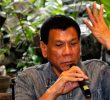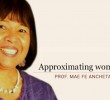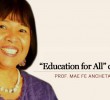It is important to utilize our own researches, and the relevant study to intelligently comprehend the need or no need to lengthen any education sub-cycle is a local study presented by ABRAHAM “ABE” I. FELIPE and CAROLINA C. PORIO as a paper for the Philippine Education Research Journal © 2010. The following statements by the two concerned and enlightened social scientists help us continue appreciating the TIMSS results in the context of our concrete conditions:
1. The results of recent comparative testing in science and mathematics of students from various countries (TIMSS) have contributed to an over-reaction to the “quality” of Philippine education. Briefly, TIMSS has contributed to the conclusion that the “quality” of Philippine education was poor. This conclusion is, of course, misleading…
The rationale of the proposal to lengthen the educational cycle in the Philippines is really driven by a purpose more complex than a plain need to improve quality of Philippine education… there were indications of a Philippine interest to comply, regardless of the cost and the uncertainty of the outcome. This could be the reason why the views on the matter were sought from the candidates for the 2010 presidential elections. |
Up to this time, the relation between the performance on TIMSS and the length of the educational cycle has not been studied properly. Claims about performance and cycle length have only been impressionistic and often erroneous.
2. As for the Philippines, a scrutiny of the… charts would show her repeatedly ending up at or near the bottom. This observation seems to have been the sole basis for the proposal to lengthen the Philippine education cycle… Considering the findings from other countries, however, attributing the results to the length of the Philippine cycle is neither objective nor correct. The evidence is clear and irrefutable: some countries have short sub-cycles, but have high scores; other countries have long sub-cycles but have low scores.
(The distribution of test results does not follow a clear rule. Some countries with short cycles had high TIMSS results; others with long cycles also had low TIMSS results).
3.
The only predictable thing about the Philippine results is that they are at the bottom of one test pile after another test pile. But the piles do not arrange themselves by some coefficient of cycle length. There are more reasonable explanations for the Philippine outcome. As an action plan to improve Philippine education, lengthening the cycle has no justification from TIMSS. |
Conclusion
Based on the present study by Felipe and Porio, there is no basis to expect that lengthening the educational cycle, calendar-wise, will improve the quality of education. The highlight in this study is that it is lengthening the pre-school sub-cycle that will be the step to take in order to improve “quality”, but needs more serious statements. Moreover, Felipe and Porio said, “One cannot just continue lengthening pre-schooling from kindergarten down to the period for oral and anal training because of sheer limits of time. Further, nothing is known about the relation of experiences during these early periods to competence in mathematics and the sciences, which are the subject of TIMSS. The importance of the pre-school sub-cycle is better interpreted to mean the presence of a strong economy and the value and support for good teaching”.
The duo further concluded that the value of the 12-year cycle is ultimately a matter of weighing the large and certain costs against the uncertain gains in lengthening the education cycle. However, one can adopt a guideline in weighing these costs and gains.
Subscribing to the Felipe and Porio study results with the realities of the Philippine education system that is colonial, commercialized, elitist, positivist and feudal-patriarchal, the majority marginalized, vulnerable, oppressed and exploited, Filipinos suffer more in the K-12 formula.
Recommendations
As a concerned social worker-educator, recommendations outlined below may still be relevant even as today’s clamor is more inclined to postponement of the implementation of the law on K to 12 strategy.
1. Address the basic problems of the Filipino people, namely: landlessness; unemployment; inadequate social service delivery and its absence for the underserved rural areas; land and crop conversion; and destructive natural and mining resource utilization by the foreign monopoly capitalists.
2. Pursue the peace process with the revolutionary groups mainly, the National Democratic Front and the Moro people’s liberation groups (while MILF’s BBL is under scrutiny) guided by the lessons of the past negotiations and agreements, especially concentrating on genuine socio-economic reforms. The reference for this may be the Mindanao People’s Agenda as constructed by the Sowing the Seeds of Peace, an interfaith people’s organizations’ network of peace advocates in Mindanao.
3. Borrowing Felipe and Porio’s guideline, individuals who are inconvenienced by non-standardized cycles should be the ones to bear the costs of reducing those inconveniences. People in the farms and small barangays should be spared the burden of a system that will not benefit them. The government could help those interested in foreign studies and work placement by supporting an appropriate system of assessment, rather than tinker with the whole cycle length. This solution addresses the alleged problem in a more focused way and does not indiscriminately impose on every Filipino the costs of meeting the needs of a few.










